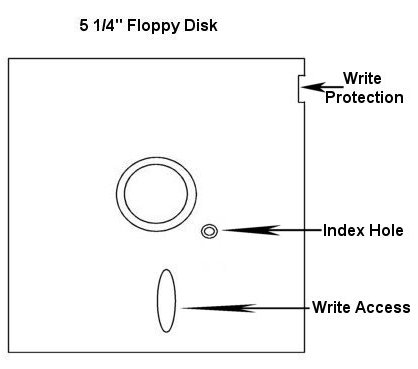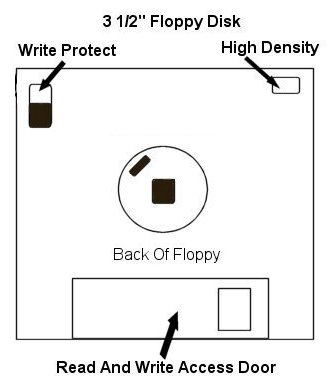
Computer Hardware Information about computer floppy drives Originally created in 1967 by IBM. The floppy reference is derived from the floppy media that is encased within the protective casing. This media is a magnetic medium and is written to much like the method used by hard disk drives. Floppy drives have been found in computers for several years and are commonly still being used today. The next generation of floppy drives will more then likely be the LS-120 diskette drives which are already being included in many computers now. FLOPPY HISTORY 8" Disk - The first disk was introduced in 1971. The disk was 8" in diameter with a magnetic coating, enclosed in a cardboard case with the capacity of one megabyte. Conversely to hard disks, the heads actually touch the disk, like in a cassette or video player which actually wears the media. 3 1/2" FLOPPY DISKETTE 3.5" Disk - Created by IBM in 1984, which even today are still commonly used. Most 3 1/2" newer disks have a capacity of up to 1.44MB. 3.5" Double Density - 720KB 3.5" High Density - 1.44MB 3.5" Extended Density (IBM ONLY) - 2.88MB 3.5" FLOPPY DISKETTE Below is a picture of the now commonly used 3.5" floppy diskettes. The below representation is what the back of a floppy diskette looks like. As you can see there are four main visible parts: First - the top left of the back of the floppy there is a small tab. This tab enables the floppy disk to be switched from write protected and un-write protected. Move the tab to the top position creating a hole makes the disk write protected. This means that nothing can be written, erased or deleted from the diskette. Moving the tab to the bottom position allows the disk to be un-write protected. Which means the diskette can be written too, erased and or have information deleted from the diskette. Some diskettes which are generally cheaper diskettes will be missing this tab. To write information to the diskette you will have to place a piece of scotch tab over the hole. Second - the top right hand of the back of the floppy you will notice a small whole. This tells the computer if the diskette within the computer is a High Density diskette. Third - you will notice the circular metal disk in the middle of the floppy diskette. This is used to rotate the magnetic medium within the floppy disk casing. Fourth - you will see a metal door which can be moved left and then will snap back to its original position. This door is used to allow the read/write head within the floppy drive to have the capability of accessing the magnetic medium within the casing. Once the diskette is removed this door will snap back into position helping to prevent anything from getting on the magnetic medium and destroying it. 5 1/4" FLOPPY DISKETTE 5.25" Disk - 160KB first Created in 1976 and later becoming a standard in 1978. 5.25" Single Side - 160KB 5.25" Double Side - 360KB 5.25" Double Side High Density - 1.2MB Below is picture of a 5 1/4" floppy commonly used in 1980's and is generally no longer used today. The 5 1/4" floppy diskette was really floppy (flimsy) when compared to the 3.5" floppy diskette. As you can notice in the above illustration the 5 1/4" floppy does not have many involved components. First - you will notice the Write protection tab which would be present if the diskette allowed information to be written to it. Placing a piece of tape over the hole or if the hole was not present this would make the diskette write protected. Second - you should notice the large hole in the center of the floppy diskette. This hole allowed the platter within the floppy to be rotated allowing the information to be read from the write access hole. Third - you should notice the Index hole this hole was the computers way of knowing where the starting point of the sector was on the diskette by physically having a hole punched in the film disc within the plastic casing. Finally you should notice the write access hole. This is the location which information would be read from as the disc within would rotate. However because there was no protection like that found on the 3.5" floppy diskette the 5 1/4" floppy diskette was generally protected by placing it within a protective sleeve. |




Back To Computer Hardware & MS-DOS Information Main Page |